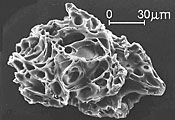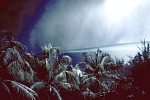What is Volcanic
Ash?
|
 Volcanic
ash consists of tiny jagged pieces of rock and glass. Ash is hard,
abrasive, mildly corrosive, conducts electricity when wet, and does
not dissolve in water. Ash is spread over broad areas by wind. Volcanic
ash consists of tiny jagged pieces of rock and glass. Ash is hard,
abrasive, mildly corrosive, conducts electricity when wet, and does
not dissolve in water. Ash is spread over broad areas by wind.
|
What is it like during ash fall?
 Falling
ash can turn daylight into complete darkness. Accompanied by rain
and lightning, the gritty ash can lead to power outages, prevent
communications, and disorient people. Falling
ash can turn daylight into complete darkness. Accompanied by rain
and lightning, the gritty ash can lead to power outages, prevent
communications, and disorient people.
|
|
|
Guidance for homes, business, & communities?
 Taking
action before, during, and after an ash fall can prevent or
reduce many of the damaging effects of ash. Removing ash requires
disposal sites and coordination among individuals and households,
community organizations, and businesses. Taking
action before, during, and after an ash fall can prevent or
reduce many of the damaging effects of ash. Removing ash requires
disposal sites and coordination among individuals and households,
community organizations, and businesses.
|
|
| References
and Web Links
|
- References used for this Web site: articles, books, and other materials
- Online Resources
|
|

